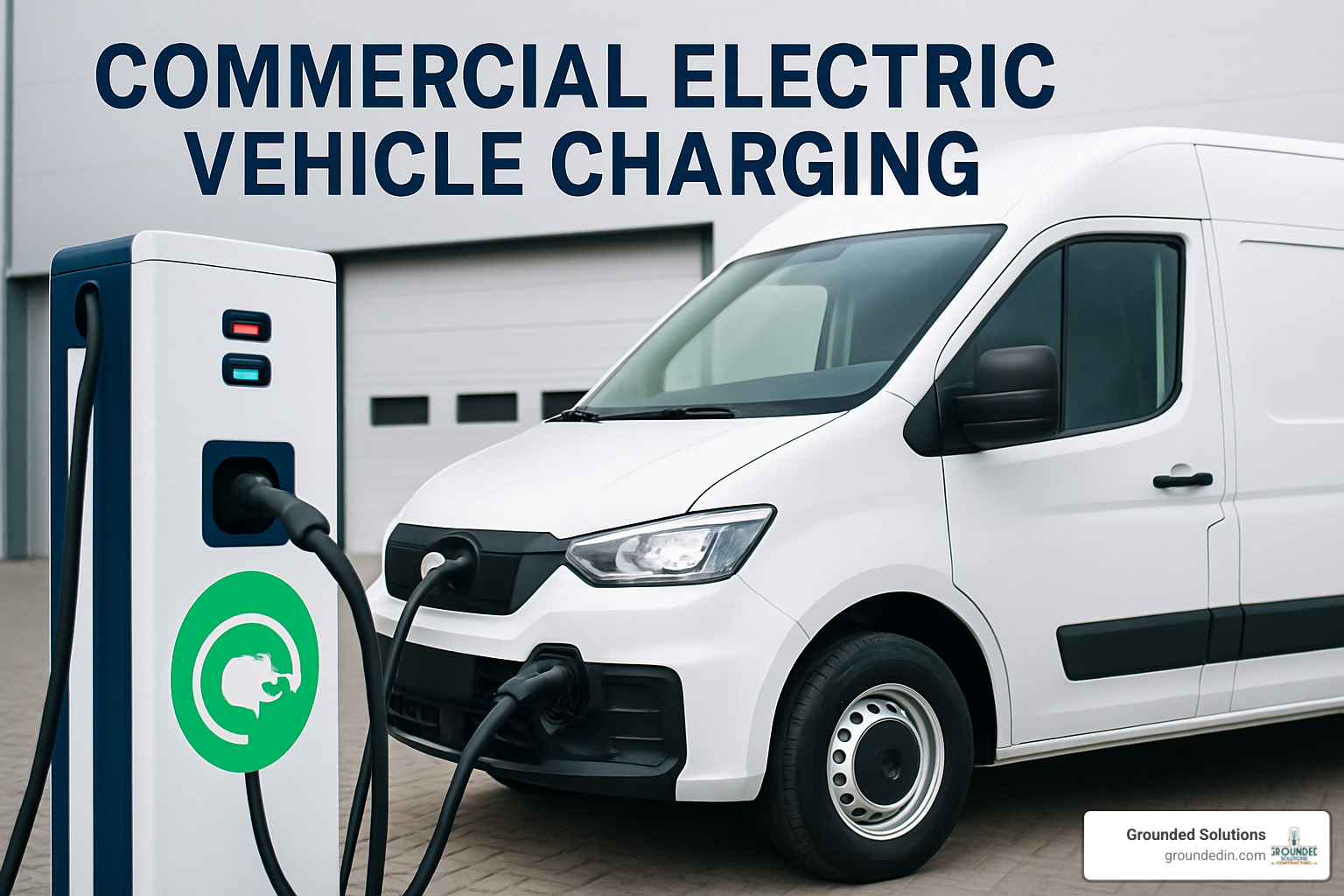Powering the Future: Commercial EV Charging Solutions
Commercial electric vehicle charging refers to the installation of EV charging infrastructure at business locations, workplaces, retail centers, and other commercial properties. These systems provide charging services for electric vehicles used by employees, customers, fleet operators, and the general public.
| Commercial EV Charging at a Glance |
|---|
| Level 2 Charging: 208/240V AC, 7-19.2 kW, adds ~25 miles of range per hour |
| DC Fast Charging: 50-350+ kW, adds 100-200+ miles in 30 minutes |
| Key Benefits: Increased property value, customer attraction, employee retention, revenue generation |
| Installation Requirements: Adequate electrical supply, proper wiring, permits, often EVITP certified installation |
| Business Models: Host-owned, provider-owned, or hybrid revenue-sharing arrangements |
As electric vehicles transform our transportation landscape, forward-thinking businesses are seizing the opportunity to install commercial charging stations. These installations not only support sustainability goals but also attract eco-conscious customers, improve property value, and potentially generate new revenue streams. With federal, state, and local incentives currently available, now is an optimal time for businesses to invest in EV charging infrastructure.
Commercial charging stations differ significantly from residential units in their power capacity, durability, and management capabilities. While home chargers typically deliver around 7 kW, commercial units can provide up to 19.2 kW for Level 2 charging, and DC fast chargers can deliver hundreds of kilowatts for rapid charging. These systems also include features like payment processing, access control, and usage analytics that are essential for commercial applications.
I’m Clay Hamilton, President of Grounded Solutions, bringing over 20 years of hands-on expertise in electrical systems and infrastructure development, including commercial electric vehicle charging projects throughout Central Indiana that have helped businesses future-proof their properties while meeting growing EV demand.
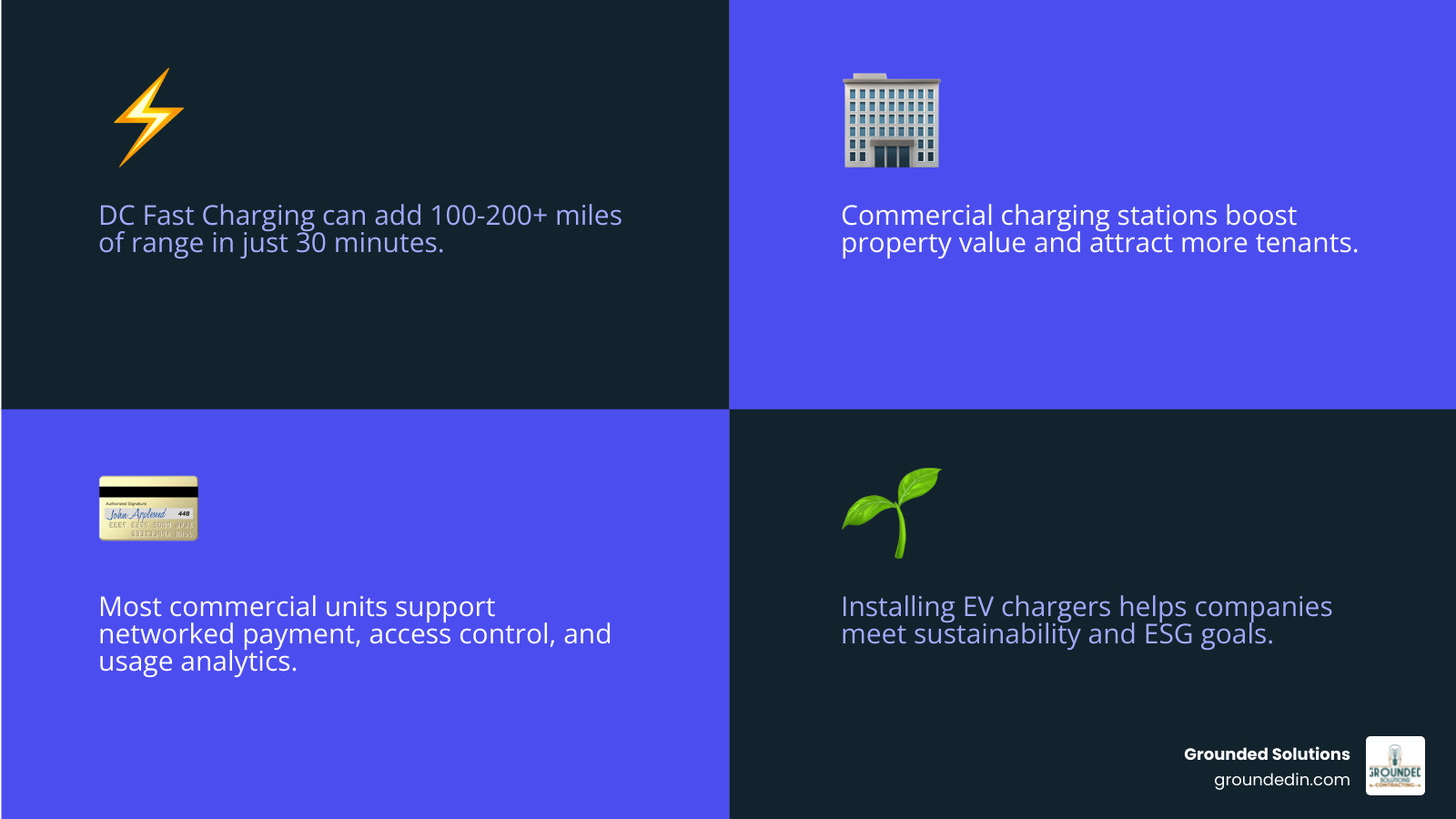
Why Install a Commercial EV Charging Station at Your Property?
“Why should I invest in EV charging now?” This is the question we hear most often from business owners across Central Indiana. The answer goes well beyond simply keeping up with trends.
Commercial electric vehicle charging stations have become powerful magnets for attracting both customers and talented employees. We recently installed four Level 2 chargers at a Carmel office park, and the property manager shared something remarkable: “We’ve seen a 15% increase in job applications since promoting our workplace charging program, and several employees have purchased EVs specifically because they can charge at work.”
For commercial property managers throughout Indianapolis and the surrounding communities, EV charging is rapidly becoming a must-have amenity. Tenants aren’t just asking for it—they’re demanding it. Recent market data shows properties with EV infrastructure command 3-8% higher lease rates compared to similar properties without charging capabilities.
Retail businesses across Fishers, Noblesville, and Greenwood are finding another compelling benefit: increased dwell time. When EV drivers plug in, they typically spend 30-60 minutes longer at your location than non-EV customers. A Greenwood shopping center manager put it simply: “Our retailers report that EV-driving customers spend an average of 23% more per visit compared to customers who don’t use our charging stations.”
For businesses with fleet vehicles operating throughout Central Indiana, the case becomes even stronger. Fleet electrification reduces operational costs, improves sustainability metrics, and protects against rising fuel costs. It’s not just about today—it’s about future-proofing your business for tomorrow.
Tangible Business Benefits
The revenue potential from commercial electric vehicle charging extends far beyond just selling electricity. Working with businesses throughout Indianapolis, we’ve seen how charging stations drive real results:
Direct charging revenue can generate $2-4 per hour for Level 2 charging sessions, but that’s just the beginning. Businesses consistently report 10-20% increased foot traffic after installing visible charging stations. Many of our clients have successfully integrated EV charging into their existing customer loyalty programs, creating powerful incentives for repeat business.
In competitive markets like Carmel, Fishers, and Zionsville, being the business with convenient charging gives you a meaningful edge over competitors. As one Westfield restaurant owner told us: “We installed two charging stations in our parking lot last year. They’ve paid for themselves already just in the additional dessert and drink orders from customers who stay longer while their cars charge.”
Sustainability & Corporate Responsibility
Beyond the direct business benefits, commercial electric vehicle charging installations demonstrate your commitment to sustainability and social responsibility. This increasingly matters to customers, employees, and investors alike.
By supporting EV adoption, your business directly contributes to reduced carbon emissions in your local community and improved air quality around your property. You’re establishing yourself as a leader in sustainable business practices, which resonates deeply with today’s conscious consumers.
Many of our clients have also finded that EV charging infrastructure helps qualify for LEED or other green building credits. A Carmel office complex we worked with last year shared: “Our building achieved LEED Gold certification partly due to our EV charging infrastructure. That certification has helped us attract premium tenants who share our sustainability values.”
For businesses throughout Indianapolis and Central Indiana, installing charging infrastructure isn’t just good for business today—it’s an investment in your company’s reputation and values for years to come. It’s about positioning your business at the forefront of the energy-efficient future that’s rapidly approaching central Indiana.
Understanding Commercial Electric Vehicle Charging
To make informed decisions about commercial electric vehicle charging, understand the different types of charging equipment available and their applications.
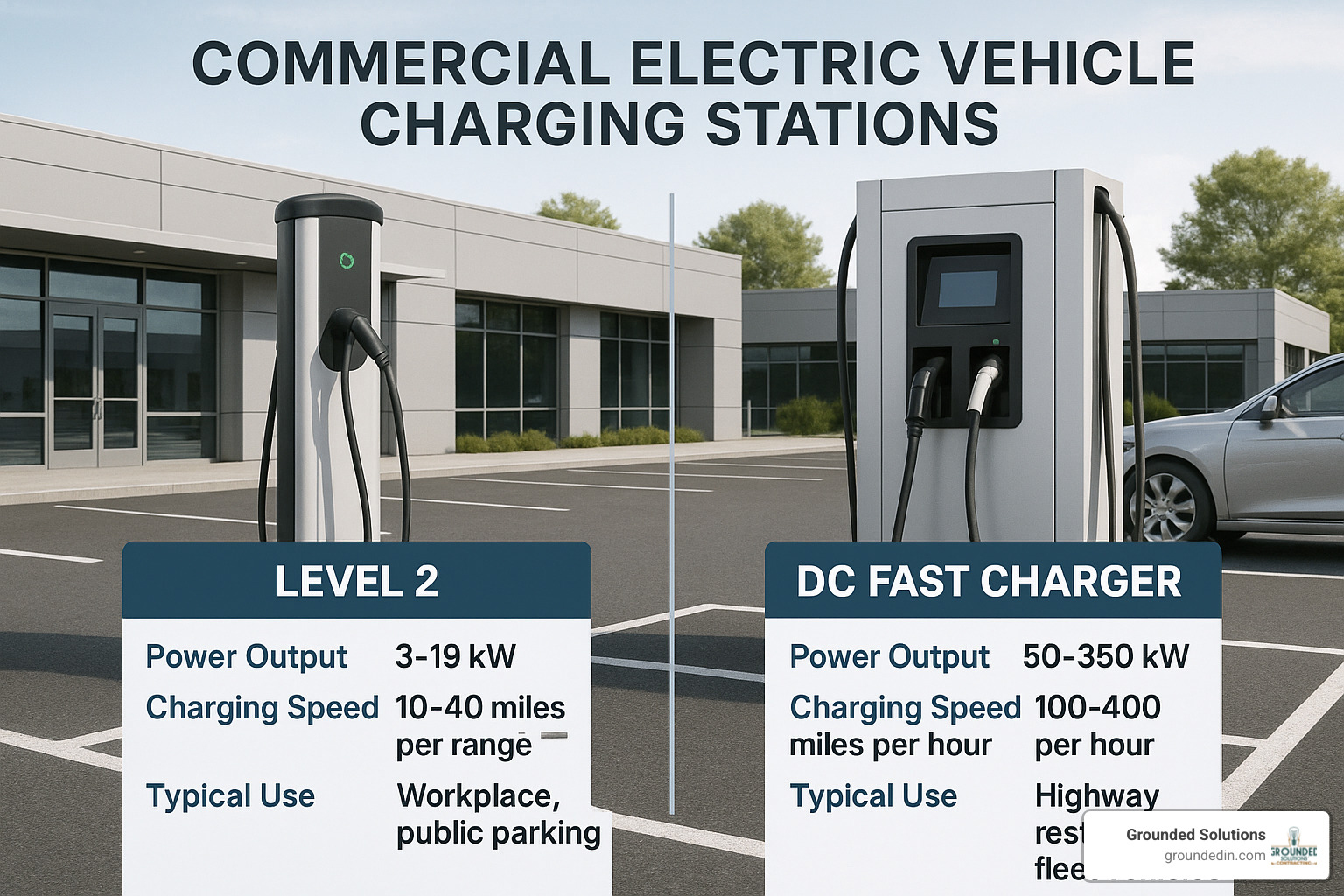
How Commercial Chargers Differ from Home Units
When we talk with Indianapolis business owners about upgrading from residential to commercial charging equipment, they’re often surprised by the significant differences between the two.
Commercial electric vehicle charging stations are workhorses built for public use, not just occasional charging. While your home charger might be perfectly adequate for overnight charging of a single vehicle, commercial units are designed with durability and multiple users in mind.
The power capacity difference is substantial. Your typical home charger delivers around 7.2-11.5 kW, but commercial Level 2 stations can pump out up to 19.2 kW per port. As one Carmel business owner told us, “My employees get nearly twice the range in the same lunch break compared to charging at home.”
Most commercial units also feature multi-port capabilities, allowing several vehicles to charge simultaneously from a single station. This maximizes your available electrical infrastructure without requiring separate installations for each parking space – a real cost-saver for many of our clients.
The brains of these systems are impressive too. Unlike basic home units, commercial chargers include sophisticated networking that handles everything from payment processing to access control. Our clients particularly value the ability to monitor usage remotely, track charging sessions, and generate reports for sustainability initiatives.
Indiana weather can be brutal – from sweltering summer heat to icy winter storms. Commercial units are built to withstand these extremes year after year. As a Noblesville property manager shared with us, “Our commercial units have survived two harsh winters without a hiccup, while my home charger needed replacement after just one season.”
We also help our clients steer ADA compliance requirements, which affect station height, cable management, and parking space design. Getting this right from the beginning prevents costly retrofits later.
Types & Typical Use-Cases
When helping our central Indiana clients select the right charging solution, we consider three main categories:
Level 1 Charging uses standard 120V outlets and adds about 5 miles of range per hour. While we rarely install these for commercial settings (they’re just too slow for most applications), they occasionally make sense for small workplaces where employees park for entire 8-hour shifts and only need a modest range boost.
Level 2 Charging is the sweet spot for most commercial installations across Indianapolis, Carmel, and Fishers. Operating at 208-240V, these systems add approximately 25 miles of range per hour – perfect for locations where vehicles park for 1-4 hours. We’ve installed Level 2 chargers at offices, restaurants, malls, and apartment complexes throughout central Indiana with great success.
“Our Level 2 stations have become a real draw for our restaurant,” a Westfield business owner told us. “Customers can enjoy a leisurely meal while their car gains 40-50 miles of range. It’s a perfect match.”
DC Fast Charging is the powerhouse option, adding 100-200+ miles in just 30 minutes. These systems convert AC power to DC before it enters the vehicle, bypassing the car’s onboard converter for much faster charging. They’re ideal for highway corridors, busy retail locations with high turnover, and electric fleet operations.
These systems require significant electrical infrastructure, typically three-phase power, and outputs range from 50 kW for basic systems to a whopping 350+ kW for the latest ultra-fast chargers. When we installed a bank of DC fast chargers at a Greenwood shopping center, the property manager noted, “These chargers have put us on the map for EV drivers traveling the I-65 corridor.”
For workplace installations, we typically recommend Level 2 charging stations. They provide enough power for employees to gain significant range during their workday without requiring expensive electrical upgrades to your facility.
Retail settings often benefit from a mixed approach. A Level 2 charger serves customers who shop for an hour or two, while a DC fast charger attracts quick-stop customers and travelers needing a rapid charge.
Fleet operations require more specialized solutions. For a Plainfield delivery company, we installed overnight Level 2 charging for their entire fleet, with smart load management that minimizes demand charges while ensuring all vehicles are fully charged by morning dispatch time.
Whatever your commercial needs, understanding these fundamental differences helps you make the right investment for your specific situation and location in central Indiana.
Site Planning & Power Requirements for Central Indiana Projects
Proper site planning is critical to the success of any commercial electric vehicle charging installation. This is where our deep experience with Central Indiana’s electrical infrastructure, soil conditions, and local codes becomes invaluable.
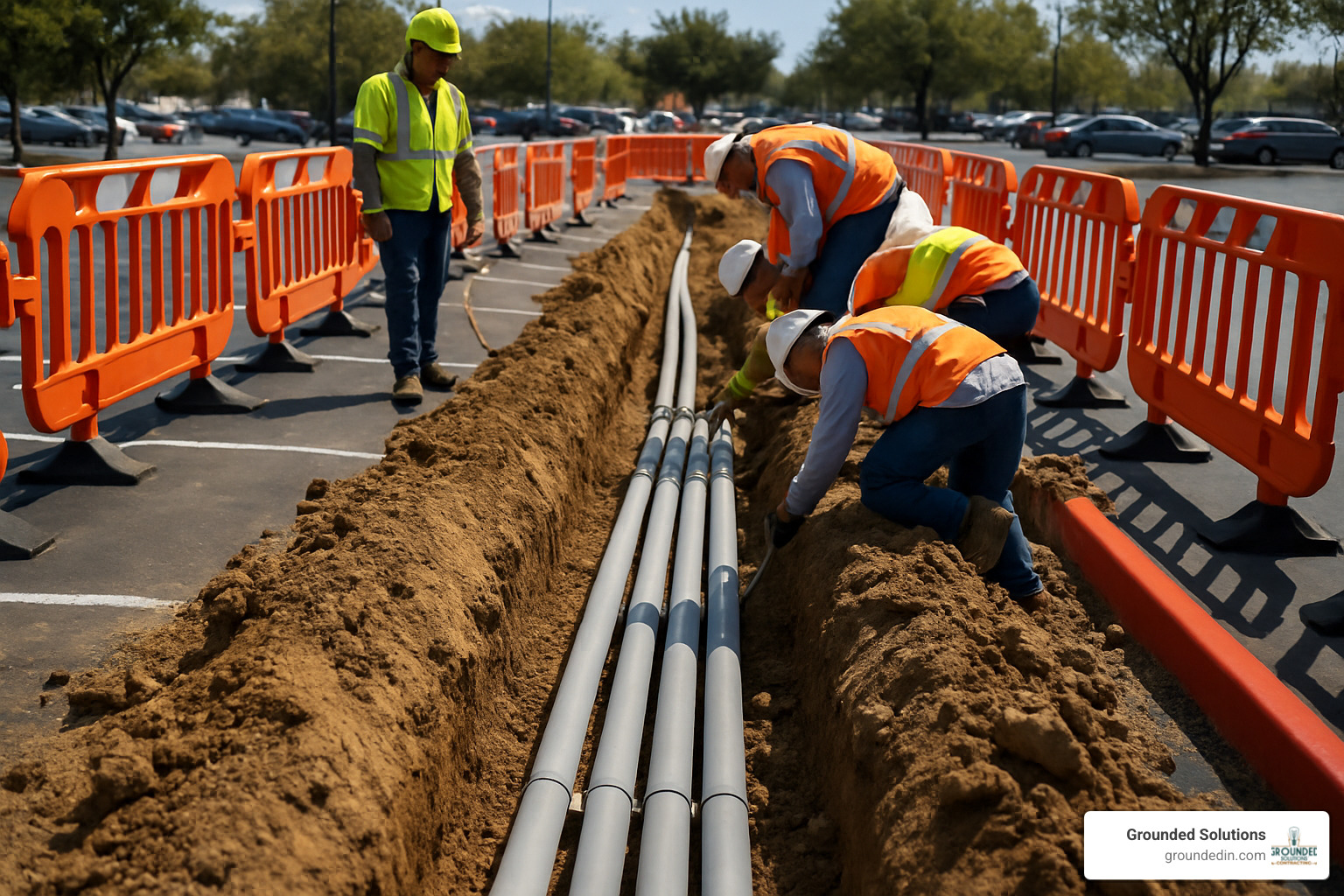
When we begin a commercial charging project, we always start with a thorough site assessment. I remember walking a property in Carmel with a business owner who was surprised at all the factors we needed to consider beyond just “where the chargers would look good.”
First, we evaluate your electrical capacity. Those sleek Level 2 chargers each need a dedicated 40-80 amp circuit at 208-240V, while DC fast chargers are much hungrier, requiring three-phase power and service capacity from 50 to 350+ kW. Many buildings in Indianapolis and surrounding areas weren’t originally designed with this kind of capacity in mind.
As one Fishers client told me, “I thought we could just plug these things in anywhere!” That’s rarely the case, but our team knows how to work with your existing infrastructure or plan appropriate upgrades when needed.
The distance from your electrical service matters too. Every foot between your panel and the charging station location adds cost for trenching, conduit, and wire. We help find that sweet spot between high-visibility locations that attract users and practical installation considerations that won’t break your budget.
We also carefully consider your parking layout. Charging stations need room not just for the equipment, but for the vehicles using them and the people accessing them. Plus, we ensure everything meets ADA requirements – something many DIY installations miss.
One of my favorite planning conversations happened with a property manager in Greenwood who was thinking about future expansion. “We’re starting with four stations, but what happens when every third car is electric in five years?” We designed their system with future expansion in mind, installing additional conduit during the initial construction. When they added six more stations last year, they saved thousands on construction costs.
Excavation and Civil Prep Essentials
If you’ve lived through an Indiana winter, you know our freeze/thaw cycles can wreak havoc on anything in the ground. That’s why proper excavation and civil preparation are crucial for long-lasting commercial electric vehicle charging installations.
We typically bury conduit 24-36 inches deep with appropriate bedding materials to prevent damage from our seasonal ground shifts. This might seem excessive, but I’ve seen too many shallow installations fail after just one harsh winter.
Bollard placement is another critical consideration. These protective posts shield your charging equipment from accidental vehicle impacts (which happen more often than you’d think!). Their foundations need to account for our local soil conditions and frost line depth to remain secure year-round.
Indiana’s unpredictable weather also means we pay special attention to water drainage. Proper grading prevents water from pooling around charging equipment – particularly important during our spring downpours and winter melt cycles.
I remember a site in Noblesville where we identified poor drainage that would have left chargers sitting in puddles after every rain. By adjusting the site plan before installation, we prevented what would have been costly electrical issues down the road.
Clear signage and wayfinding help drivers locate and properly use your charging stations. This isn’t just about convenience – proper signage ensures compliance with local regulations and helps prevent non-EV vehicles from occupying charging spaces.
After all the underground work is complete, proper surface restoration ensures your property looks as good as it functions. Whether we’re working with asphalt, concrete, or pavers, our team restores disturbed surfaces to match the surrounding area, maintaining your property’s professional appearance.
Future-Proofing Your Infrastructure
The EV market is evolving rapidly, and what seems adequate today might not meet your needs tomorrow. That’s why we approach every commercial electric vehicle charging project with future expansion in mind.
One simple but effective strategy is installing oversized conduit – larger than immediately needed for your initial wire pulls. This small upfront investment can save thousands in re-excavation costs when you decide to expand.
We also recommend modular hardware that can be upgraded through component replacement rather than complete system replacement. As one business owner in Broad Ripple told me, “I love that we can upgrade the charging technology without ripping everything out and starting over.”
Dynamic power sharing systems are becoming increasingly popular in Central Indiana. These smart charging networks allocate available power across multiple vehicles, maximizing the use of limited electrical capacity. For businesses concerned about utility demand charges, this technology can make a significant difference in operating costs.
We’re also seeing growing interest in battery storage integration. As battery costs continue to fall, pairing storage with charging infrastructure becomes more attractive for demand charge management and resilience during power outages.
Looking further ahead, vehicle-to-grid (V2G) compatibility ensures your system can adapt to emerging technologies that allow electric vehicles to supply power back to buildings or the grid during peak demand periods.
A forward-thinking medical office in Zionsville recently worked with us on a comprehensive charging installation that incorporated all these future-proofing elements. Their system started with six Level 2 stations but can easily expand to twenty-four as demand grows. The property manager told me, “We wanted to do this once and do it right, not keep digging up our parking lot every few years.”
By planning thoroughly and looking ahead, your commercial EV charging infrastructure can grow with your needs while minimizing future disruption and expense.
The Step-by-Step Installation Journey
Installing commercial electric vehicle charging stations isn’t just about plugging in equipment—it’s a journey that requires careful planning and execution. Let me walk you through what this process really looks like for our Central Indiana clients.
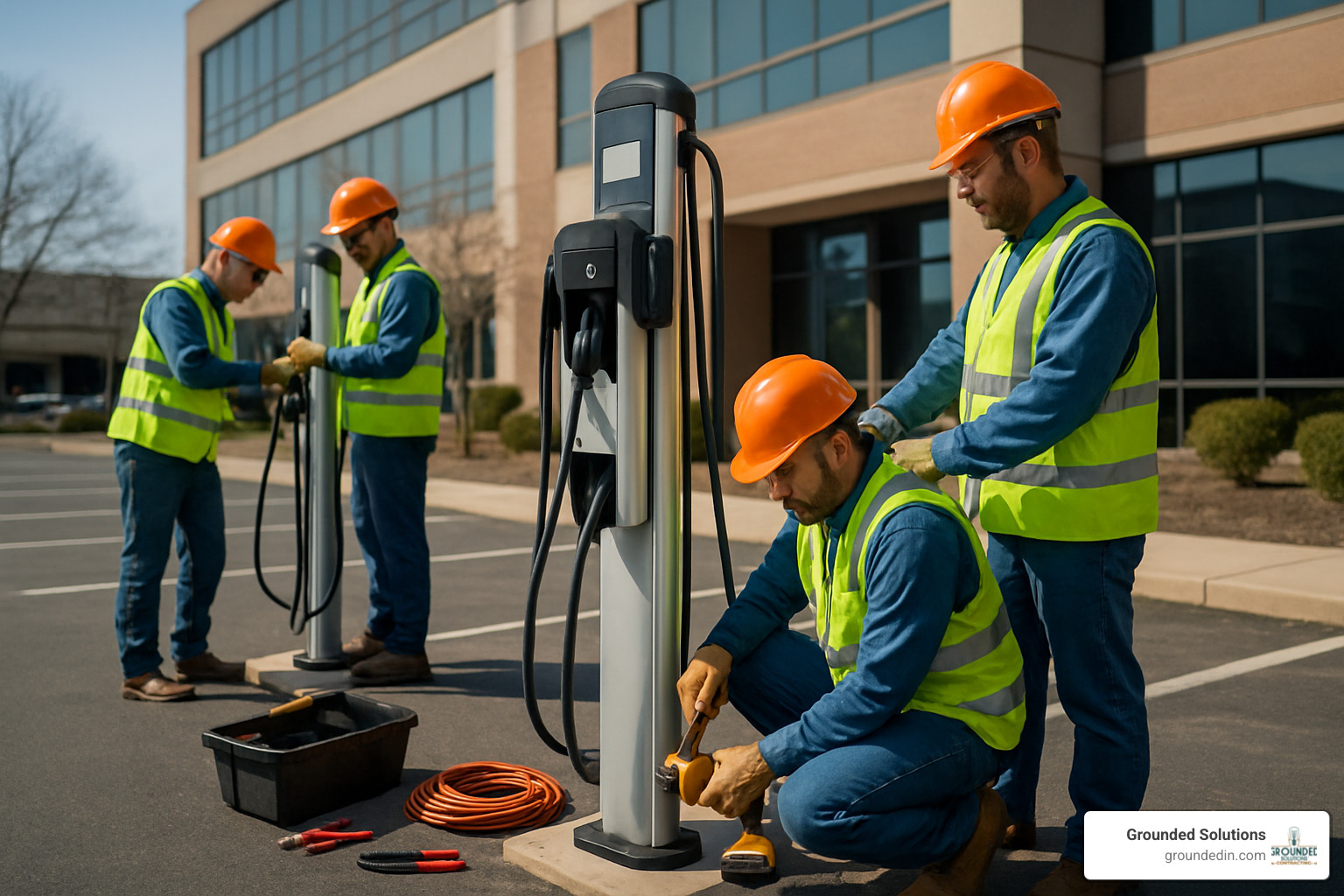
When we partnered with a retail development in Greenwood on their 12-station installation, their operations manager told us afterward: “Grounded Solutions managed everything from design through commissioning with remarkable precision. Their detailed timeline helped us communicate with tenants about temporary parking disruptions, and the actual installation matched their schedule almost to the day.”
The journey typically begins with a 2-4 week planning phase where we conduct a thorough site assessment and electrical load analysis. This is when we help you select the right chargers based on your specific business needs and what your site can support. We’ll create preliminary designs, provide transparent cost estimates, and coordinate with your utility company if service upgrades might be needed.
Next comes the permitting dance, which usually takes 2-6 weeks in Central Indiana. We handle all the paperwork—electrical permits, structural permits for any canopies or extensive site work, utility approvals for service modifications, and local planning department sign-offs for parking changes. Our familiarity with local code requirements throughout Indianapolis and surrounding communities helps avoid delays that often plague these projects.
Once approvals are in hand, the physical change begins. Site preparation typically takes 1-2 weeks, with our crews handling trenching and conduit installation with minimal disruption to your operations. We’ll construct concrete pads for pedestal chargers, install protective bollards, and take care of parking space painting and signage installation—all with an eye toward both functionality and aesthetics.
The electrical installation phase follows, usually requiring 1-2 weeks depending on complexity. This includes any necessary panel and service upgrades, running wiring from your electrical source to charging locations, mounting and connecting the charging equipment itself, and carefully testing all electrical connections to ensure safety and reliability.
Finally, we reach the commissioning and activation stage—the moment when your investment comes to life. This typically takes about a week as we schedule final electrical inspections, establish network connections, configure payment systems, and provide thorough training for your staff on system operation. We don’t consider a project complete until you’re fully comfortable managing your new charging infrastructure.
For more comprehensive information about the installation process and ongoing support, check out our detailed guide on Commercial EV Charger Installation and Maintenance.
Networking, Payment & Access Control
Today’s commercial electric vehicle charging stations are far more sophisticated than simple power outlets. They’re smart, connected systems that can be custom to your specific business needs.
Modern charging networks offer remarkable flexibility in user authentication. For a hotel in downtown Indianapolis, we implemented a system where guests use their room key cards for free charging while public users pay market rates through a mobile app. This creates both a valuable guest amenity and a new revenue stream.
Payment processing options have evolved significantly as well. Depending on local regulations, you can bill per kilowatt-hour, charge based on time connected, implement session fees, or create a hybrid approach. Many of our clients in office parks around Carmel and Fishers offer free or discounted charging to employees while charging higher rates to visitors—all managed automatically through the same equipment.
Access control features let you determine exactly who can use your chargers and when. Time-of-day restrictions, user group permissions, reservation capabilities, and idle fee enforcement all help ensure your charging infrastructure serves its intended purpose. A medical office in Noblesville uses this capability to reserve chargers for physicians during morning hours, then opens them to all staff in the afternoon.
Perhaps most impressive are the energy management capabilities. Modern systems can balance load across multiple stations, schedule charging to avoid peak demand periods, integrate with your building’s energy management system, and even participate in utility demand response programs—potentially creating new revenue opportunities while reducing operating costs.
Ongoing Operations & Maintenance
The day your commercial electric vehicle charging stations are commissioned is just the beginning of our relationship. Reliable operation requires ongoing attention, and that’s where many charging providers fall short.
A property manager in Noblesville shared her experience: “Our previous charging provider installed the equipment and essentially disappeared. With Grounded Solutions, we have quarterly preventive maintenance visits and immediate response when issues arise. The difference in uptime has been remarkable.”
Remote monitoring forms the foundation of our maintenance approach. We implement real-time status monitoring with automated alerts for malfunctions, allowing us to often address issues before you even notice them. We also analyze usage patterns to help optimize performance and maximize return on your investment.
Our preventive maintenance program includes quarterly visual inspections where we assess cable and connector conditions, clean screens and user interfaces, and ensure all software and firmware are up to date. This proactive approach dramatically reduces unexpected downtime and extends equipment life.
When issues do arise, our responsive service makes all the difference. We provide 24/7 technical support, rapid response to equipment failures, a comprehensive parts replacement program, and user support for charging issues. Your reputation is on the line when someone’s vehicle is connected to your charger—we make sure that experience reflects positively on your business.
The journey from concept to fully operational commercial electric vehicle charging infrastructure requires expertise at every step. As central Indiana’s EV charging specialists, we guide you through this process with the care and attention to detail that only a local, family-owned business can provide.
Incentives, Funding & ROI for Indiana Businesses
The financial case for commercial electric vehicle charging becomes even more compelling when you factor in the impressive array of incentives available to Indiana businesses. As we’ve helped dozens of Central Indiana companies steer these opportunities, we’ve seen how they can transform the economics of an EV charging project.
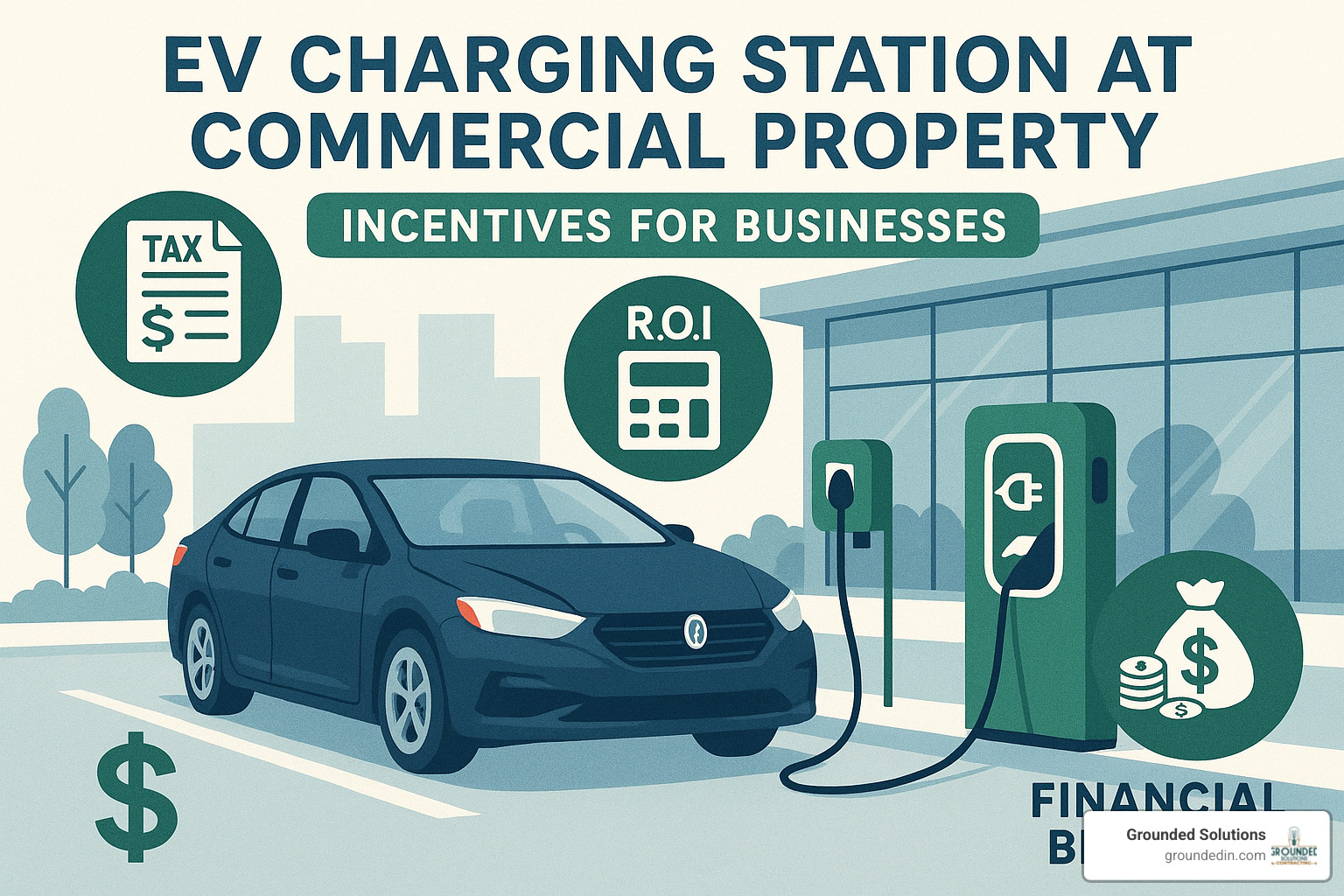
Federal Incentives
Washington has made EV infrastructure a priority, and that translates to substantial savings for your business. The Alternative Fuel Infrastructure Tax Credit covers 30% of your qualified charging equipment and installation costs, up to $100,000 per site. That’s not pocket change!
Beyond this direct credit, the Modified Accelerated Cost Recovery System (MACRS) lets you depreciate EV charging assets over just 5 years rather than the typical 39 years for commercial property improvements. For businesses electrifying their fleets, the Commercial Clean Vehicle Credit provides additional financial support when purchasing qualified vehicles.
“The tax credits were honestly what pushed us over the edge,” shared a dental office owner in Carmel. “What seemed like a nice-to-have amenity suddenly became a no-brainer investment when we ran the numbers with our accountant.”
Indiana State and Utility Incentives
Here in the Hoosier state, we’re fortunate to have several programs supporting EV infrastructure. The Charge Ahead Indiana Program offers substantial rebates for both public and workplace charging stations. Many of our clients have successfully tapped into this funding.
Indiana’s utilities have also stepped up with their own incentives. Duke Energy’s Park & Plug Program and Indianapolis Power & Light’s EVSE incentives provide significant rebates that can dramatically reduce your upfront costs. We’ve become experts at helping clients steer these application processes, ensuring you don’t leave money on the table.
Local Incentives
Don’t overlook municipal support! Several Central Indiana communities offer expedited permitting, reduced fees, or even direct grants for businesses installing commercial electric vehicle charging stations. These local incentives might not make headlines, but they can significantly improve your project economics.
Green building certification programs like LEED also award points for EV charging infrastructure, potentially helping your property achieve or maintain certification status that commands premium values.
A restaurant owner in Fishers told us recently: “By combining the federal tax credit with our utility rebate, we cut our costs by nearly 65%. The system is already paying for itself through increased dinner reservations from EV drivers who appreciate the convenience.”
Building a Compelling Business Case
The return on investment for commercial electric vehicle charging comes from multiple revenue streams and business benefits that compound over time.
Direct charging revenue can generate $1,500-$4,000 annually per port, depending on your pricing model and usage rates. But the indirect benefits often prove even more valuable. Retail locations consistently report 15-30% higher per-visit spending from EV drivers compared to their gas-powered counterparts.
For employers, workplace charging has become a surprisingly powerful recruitment and retention tool. As one HR director in Noblesville explained: “We’ve seen job candidates specifically mention our EV charging stations as a factor in their decision to join us. In this competitive labor market, every advantage matters.”
Property owners benefit too. Commercial properties featuring EV infrastructure typically command higher lease rates and experience lower vacancy rates—a compelling advantage in today’s commercial real estate market.
Different business types see varying payback periods. Through our installations across Central Indiana, we’ve observed retail locations typically reaching payback in 2-4 years, workplace charging in 3-5 years, multi-family housing in 3-4 years, and hotels achieving payback in just 2-3 years.
Want to explore available incentives in more detail? Visit GoElectricDrive or learn more about incentives here.
Keeping Your Project Budget-Friendly
Even with generous incentives, commercial electric vehicle charging installations represent a meaningful investment. That’s why we help our Indianapolis-area clients maximize value through several proven strategies.
Phased construction allows you to start with core infrastructure and a few stations, then expand as demand grows. This approach matches your investment to actual usage patterns while maintaining a cohesive long-term vision.
Load management technology uses smart systems to reduce required electrical capacity while serving more vehicles. This often eliminates or defers costly electrical service upgrades.
Strategic siting places stations close to existing electrical infrastructure, minimizing expensive trenching and conduit runs. Our deep knowledge of electrical systems helps identify these opportunities that less experienced installers might miss.
Incentive stacking combines federal, state, utility, and local incentives to maximize financial support. The paperwork can be daunting, but our team has walked dozens of businesses through these processes.
Financing options including equipment leasing, charging-as-a-service models, or green financing programs can transform a capital expense into a manageable operational cost.
A property manager for a Broad Ripple mixed-use development shared their experience: “Grounded Solutions helped us implement a phased approach that spread costs over three years while immediately giving us the ‘green halo’ effect of being an EV-friendly property. Their guidance on incentives saved us thousands, and their electricians worked around our tenants’ schedules to minimize disruption.”
By combining these approaches with Indiana’s available incentives, we’ve helped businesses of all sizes implement commercial electric vehicle charging solutions that make financial sense today while positioning them for the electric transportation future that’s rapidly arriving.
Frequently Asked Questions about Commercial Electric Vehicle Charging
How many charging ports should my site start with?
This is one of the first questions most of our Central Indiana clients ask, and the answer isn’t one-size-fits-all.
For most businesses in the Indianapolis area, we typically recommend starting with 2-4 Level 2 charging ports per 100 parking spaces. However, your specific needs might vary based on several important factors.
If your business is located in areas with higher EV adoption rates like Carmel, Zionsville, or north Indianapolis, you might want to start with more ports. We’ve noticed these communities tend to have more electric vehicles on the road already.
The nature of your business matters too. A workplace where employees park for 8+ hours can serve more EVs with fewer ports than a retail location with high turnover. As one Fishers office manager told us, “Our four charging ports easily serve our twelve EV-driving employees because most only need a few hours of charging during their workday.”
Perhaps the most important advice we give clients: whatever number of ports you start with, install the underground infrastructure (conduit, pull boxes, etc.) for 2-3 times that number. This future-proofing approach saves thousands when you inevitably need to expand.
For larger commercial sites or high-traffic areas like shopping centers in Greenwood or Castleton, starting with 6-10 ports might make sense, potentially including a DC fast charger to serve quick-visit customers.
What electrical upgrades are usually required for Level 2 vs. DC fast?
The electrical requirements for commercial electric vehicle charging vary significantly between Level 2 and DC fast charging systems.
For Level 2 charging stations, which are what most businesses start with, you’ll typically need:
- 208-240V electrical service
- 40-80 amps per charging port (though smart power sharing can reduce this)
- Potentially a new sub-panel if your existing electrical capacity is limited
The good news is that many commercial buildings throughout Central Indiana can accommodate a modest Level 2 installation without major electrical upgrades. For a typical four-port setup, we generally need to allocate 100-160 amps of capacity.
When we installed six Level 2 chargers at a medical office in Noblesville, we were able to work entirely within their existing electrical infrastructure by implementing a smart load management system. Their office manager was thrilled: “We thought we’d need expensive electrical upgrades, but Grounded Solutions found a way to make it work with our current system.”
DC fast charging is a different animal altogether, typically requiring:
- 480V three-phase power (though smaller units can sometimes use 208V)
- 100-400+ amps depending on the desired charging speed
- Often a dedicated transformer
- In many cases, utility service upgrades
When we installed a 150kW DC fast charger at a convenience store along I-465, the project included coordinating with the utility for a service upgrade and installing a new transformer. While more involved, this investment positioned the business as a regional fast-charging hub.
Can I restrict charger access to employees only and later open to the public?
Absolutely! Modern commercial electric vehicle charging systems offer flexible access control that can evolve with your needs.
Today’s networked charging stations allow you to:
- Limit initial access to specific users through RFID cards, mobile apps, or special access codes
- Create different user groups with varying pricing tiers (free for employees, paid for public users)
- Schedule availability by time of day or day of week
- Gradually transition from restricted to public access as your comfort level and demand evolves
We recently worked with a credit union in Carmel that wanted to offer free charging to employees during business hours while making the stations available to the public on evenings and weekends. Their networked charging system automatically switches between these modes, maximizing the utility of their investment.
Another client, a mixed-use development in Broad Ripple, took a phased approach to access: “We started by only allowing employees to use the chargers. Once we were comfortable with operations, we expanded access to building tenants. Six months later, we opened to the public with a paid rate structure. This gradual rollout gave us time to learn the system and optimize our approach.”
This flexibility means you don’t have to make permanent decisions about access from day one—your charging program can grow and evolve alongside your business needs and the increasing EV adoption in Central Indiana.
Conclusion
As electric vehicles become increasingly common throughout Indianapolis and Central Indiana, commercial electric vehicle charging infrastructure is transitioning from a forward-thinking amenity to a business necessity. The businesses that act now gain several advantages:
The EV revolution isn’t coming to Central Indiana – it’s already here. Each month, I see more electric vehicles in parking lots across Indianapolis, Carmel, Fishers, and beyond. Business owners who install charging infrastructure today aren’t just preparing for the future – they’re meeting a current demand while positioning themselves for significant advantages.
Early adopters of commercial electric vehicle charging benefit from today’s generous incentive programs that substantially reduce installation costs. Many of these federal, state, and utility programs have limited funding or upcoming expiration dates. As one Fishers business owner recently told me, “The incentives covered nearly 40% of our project costs – we couldn’t have justified the investment without them.”
Beyond financial incentives, there’s the competitive edge to consider. When your business offers convenient charging while competitors don’t, you become the obvious choice for EV drivers. This creates loyalty that persists even as charging becomes more commonplace. We’ve seen this play out repeatedly with our clients across Central Indiana.
Installing chargers now also means you can select prime locations on your property rather than being forced to retrofit less desirable spaces later. This strategic placement maximizes visibility, convenience, and the marketing value of your investment.
Perhaps most importantly, planning comprehensive electrical infrastructure now – even if you’re deploying chargers in phases – dramatically reduces your total project costs. The trenching, conduit installation, and electrical service upgrades represent significant portions of any charging project budget. Doing this work once, with future expansion in mind, simply makes good business sense.
At Grounded Solutions, we’ve helped businesses across Indianapolis, Carmel, Fishers, Greenwood, and throughout Central Indiana steer the complexities of commercial EV charging installation. As a family-owned and operated electrical contractor based in Indianapolis, we bring local expertise, transparent pricing, and a commitment to quality that ensures your charging infrastructure will serve your business reliably for years to come.
Our approach combines technical excellence with practical business sense. We understand that charging infrastructure must not only work flawlessly but also contribute to your bottom line and support your business goals. As one client put it, “Grounded Solutions didn’t just install chargers – they helped us think through how to make them work for our business model.”
Ready to explore how commercial electric vehicle charging can benefit your business? Contact Grounded Solutions today for a site assessment and consultation. As your local experts in commercial electrical services throughout Central Indiana, we’ll help you steer the entire process from initial planning through ongoing maintenance, ensuring your investment delivers maximum value for your business.
